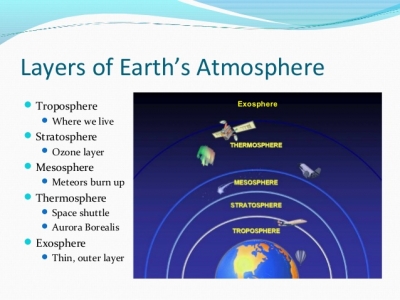
Mesosphere
The top of the mesosphere is the coldest part of the Earth’s atmosphere, with temperatures of -143°C (-226°F). Gases here are thick enough to slow down meteors, causing them to burn up. It extends upward to a height of about 85 km (53 miles) above our planet. Most meteors burn up in the mesosphere. Unlike the stratosphere, temperatures once again grow colder as you rise up through the mesosphere. The coldest temperatures in Earth's atmosphere, about -90°C (-130°F), are found near the top of this layer. The air in the mesosphere is far too thin to breathe; air pressure at the bottom of the layer is well below 1% of the pressure at sea level, and continues dropping as you go higher.
Stratosphere
The air in this layer is very dry and still. The ozone layer, which protects plants and animals on Earth from dangerous ultraviolet (UV) rays that are given off by the Sun, lies in the stratosphere. The stratosphere extends from the top of the troposphere to about 50 km (31 miles) above the ground. The infamous ozone layer is found within the stratosphere. Commercial passenger jets fly in the lower stratosphere, partly because this less-turbulent layer provides a smoother ride. The jet stream flows near the border between the troposphere and the stratosphere.
Troposphere
The gases found in the troposphere make up the air that we breathe. Therefore life exists in this layer. Starting at ground level, it extends upward to about 10 km (6.2 miles or about 33,000 feet) above sea level.Clouds form here, and it is where most of our weather occurs, mainly because 99% of the water vapor in the atmosphere is found in the troposphere. Air pressure drops, and temperatures get colder, as you climb higher in the troposphere.
Thermosphere
Unlike in other layers of Earth’s atmosphere, temperatures here increase as you go higher, some parts rising to 2000°C (3,600°F)! High-energy X-rays and UV radiation from the Sun are absorbed in the thermosphere, raising its temperature to hundreds or at times thousands of degrees. However, the air in this layer is so thin that it would feel freezing cold to us! In many ways, the thermosphere is more like outer space than a part of the atmosphere. Satellites, including the International Space Station, orbit Earth in the thermosphere.
Exosphere
This is the highest layer of Earth’s atmosphere, where it merges into space. Only a few, very thin wisps of gas are found this high above our planet. It would be impossible to breathe here! In fact, air in the exosphere is constantly - though very gradually - "leaking" out of Earth's atmosphere into outer space. There is no clear-cut upper boundary where the exosphere finally fades away into space. Different definitions place the top of the exosphere somewhere between 100,000 km (62,000 miles) and 190,000 km (120,000 miles) above the surface of Earth.
Picture Credit : Google
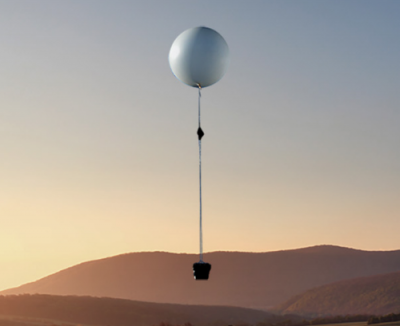

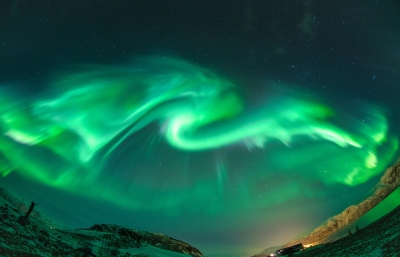
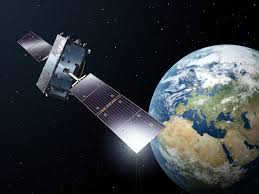

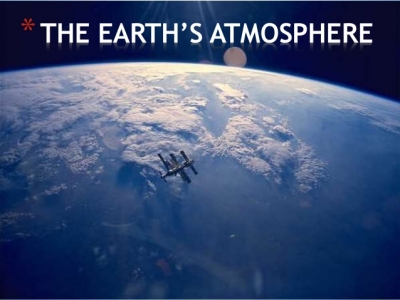


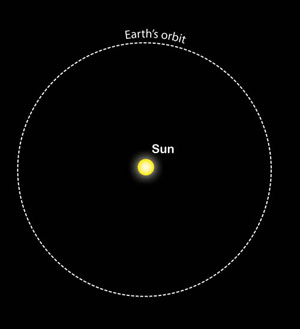
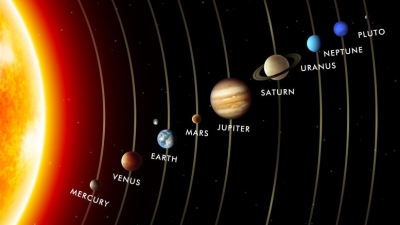
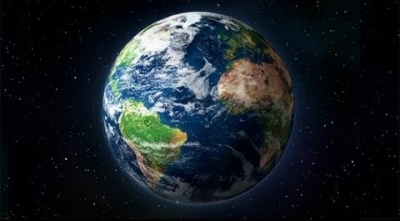
 Earth is perhaps the only planet in the solar system where life exists. This is because the conditions favourable for the existence of life are available only on the Earth. Conditions present in other planets make life almost impossible.
Earth is perhaps the only planet in the solar system where life exists. This is because the conditions favourable for the existence of life are available only on the Earth. Conditions present in other planets make life almost impossible. The heavenly bodies that revolve round the sun are called planets. There are nine planets in our solar system: Mercury, Venus, Earth, Mars, Jupiter, Saturn, Uranus, Neptune and Pluto. The bodies revolving round these planets are called their ‘satellites’ or ‘moons’.
The heavenly bodies that revolve round the sun are called planets. There are nine planets in our solar system: Mercury, Venus, Earth, Mars, Jupiter, Saturn, Uranus, Neptune and Pluto. The bodies revolving round these planets are called their ‘satellites’ or ‘moons’.

 Our Earth was born around 4.6 billion years ago. Like the Sun and other planets, it was also formed out of the clouds of dust and gases. However, before turning into present shape it was a fireball surrounded by an atmosphere of burning gases. At that time it revolved round the Sun in the form of a hot spherical body. Hundreds of years later, it gradually started moving away from the Sun while still revolving round it. As it moved farther and farther from the Sun, its temperature kept on decreasing. It started cooling off and its outer layer changed into a crust. With the hardening of this crust, cracks developed in it and molten material from inside started coming out. Over a period of millions of years, this molten material gave birth to mountains and valleys.
Our Earth was born around 4.6 billion years ago. Like the Sun and other planets, it was also formed out of the clouds of dust and gases. However, before turning into present shape it was a fireball surrounded by an atmosphere of burning gases. At that time it revolved round the Sun in the form of a hot spherical body. Hundreds of years later, it gradually started moving away from the Sun while still revolving round it. As it moved farther and farther from the Sun, its temperature kept on decreasing. It started cooling off and its outer layer changed into a crust. With the hardening of this crust, cracks developed in it and molten material from inside started coming out. Over a period of millions of years, this molten material gave birth to mountains and valleys. 